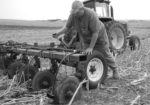Advertise Follow Us
Articles Tagged with ''Nebraska''
What I've Learned from No-Tilling
Firsthand Experience Led No-Tiller To Advocate Practice In Nebraska
Conservation of soil, a better quality of life and the time to invent the TracPacker were all benefits of no-till for Dan Gillespie.
Read More
Build Organic Matter With Diverse Cropping Rotations
Continuous no-till, along with winter wheat, field peas, proso millet and a CANULA cover crop, raised organic-matter levels and led to better water infiltration for this Nebraska no-tiller.
Read More
To Minimize Soil Disturbance, Get Rid Of The Shake
Anhydrous application can be accomplished without tearing up no-till fields.
Read More
Is Tillage OK Once Every 10 Years?
There are better ways than moldboard plowing to reduce potential phosphorus runoff in no-tilled fields, experts say.
Read More
Don’t Forget Nutrient Value When Harvesting Corn Stover
No-till corn stover could provide new revenue, but loss of nutrients from removed residue may offset income.
Read More
Cover Crops, Freeze-Thaw Cycle Favored For Undoing Compaction
An online discussion finds that most no-tillers prefer not to rip their fields and would rather rely on more natural methods to restore the structure of their valuable soils.
Read More
Stripping Secrets, Strategies
Here’s what growers learned this year about strip-tilling continuous corn.
Read More
Blade Wear Is Dangerous!
Too much blade contact with no-till planters and drills can cause premature wear on the frog or wear guard assembly.
Read More
Match-Making Pays With No-Till
For effective no-tilling, you need to know what seeding equipment will work best and what it takes for peak performance.
Read More













